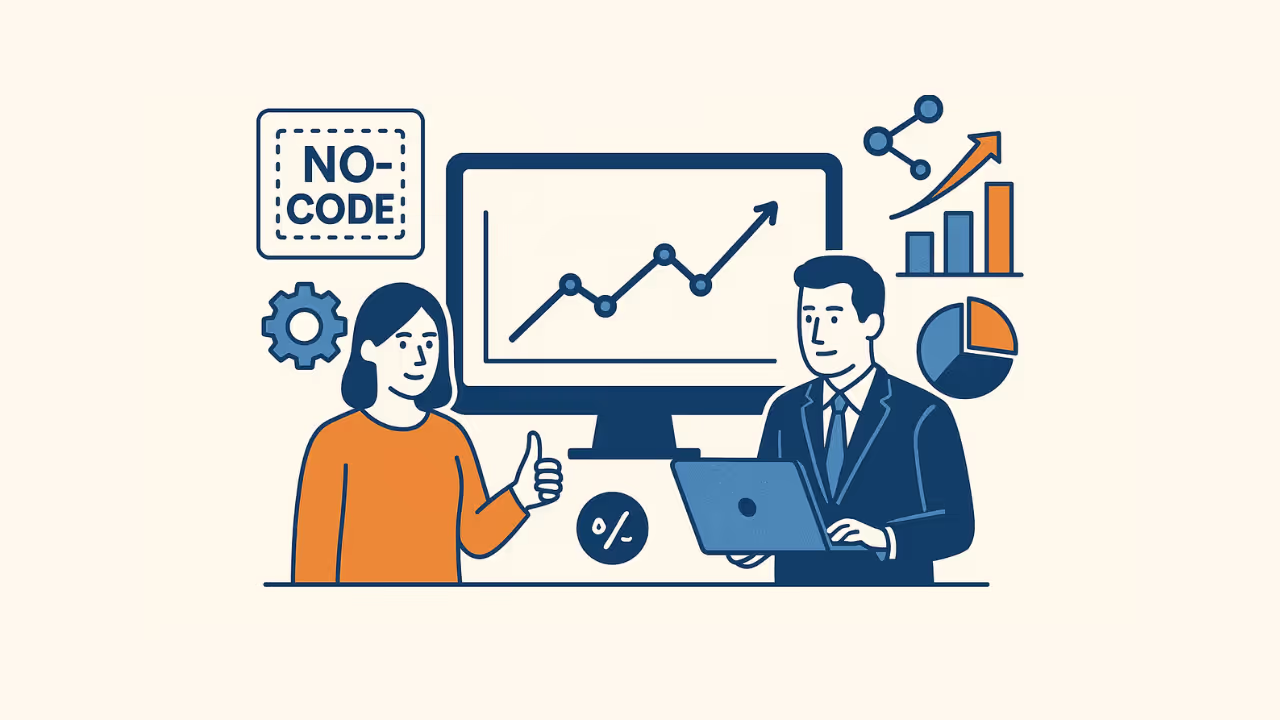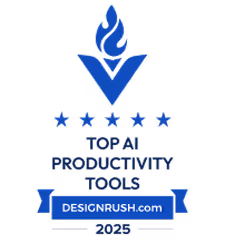AI & Analytics Glossary
The Best No-Code Analytics Tools for Enterprise Teams

Data analysis shouldn't require a computer science degree. Yet countless business teams across supply chain, finance, and operations find themselves stuck waiting for technical specialists to answer simple questions about their data. What if your procurement manager could instantly analyze supplier performance? What if your finance team could build comprehensive dashboards without writing a single line of code?
The democratization of data analytics is here. No-code analytics platforms are transforming how organizations approach data analysis, enabling anyone to explore datasets, create visualizations, and generate insights using intuitive interfaces rather than complex programming languages. For teams drowning in spreadsheets and delayed reports, these tools represent a fundamental shift toward self-service analytics.
The stakes are high. Organizations that fail to democratize data access risk falling behind competitors who can make faster, data-driven decisions. This comprehensive guide examines the leading no-code analytics platforms, helping you choose the right solution for your team's specific needs and technical requirements.
Why Are SQL-Free and Python-Free Analytics Essential for Modern Teams?
Traditional analytics creates bottlenecks that slow decision-making and limit organizational agility. When only technical specialists can query databases or manipulate data, business teams become dependent on resources that are often overloaded and expensive to maintain.
Faster Decision Cycles Drive Competitive Advantage
No-code platforms eliminate the delays inherent in traditional analytics workflows. Instead of submitting requests to IT departments and waiting days or weeks for reports, business users get immediate answers to critical questions. This acceleration enables organizations to respond quickly to market changes, supplier issues, or customer demands.
Consider a supply chain manager who needs to understand delivery performance trends. With traditional tools, this analysis might require SQL expertise to join multiple tables and calculate performance metrics. A no-code platform allows the same manager to simply ask "What were last month's average delivery times by supplier?" and receive an instant, visual response.
Reduced Total Cost
Organizations spend significantly less on training when employees don't need to learn complex programming languages before analyzing data. The cost savings extend beyond training to include reduced dependency on specialized technical staff for routine reporting tasks.
Companies also avoid the hidden costs of delayed decisions. When business teams can analyze data independently, they make faster decisions that often translate to improved efficiency, reduced costs, and better customer service.
Enhanced Data Driven Culture
When analytics tools are accessible without coding skills, more employees engage with data regularly. This broader engagement creates a data-driven culture where decisions are based on evidence rather than intuition or outdated reports.
The democratization effect is particularly powerful in organizations with diverse functional teams. Sales representatives can analyze pipeline performance, finance specialists can track budget variances, and operations managers can monitor efficiency metrics, all using the same accessible platform.
Modern no-code analytics platforms also incorporate AI tools for data analytics, making sophisticated analysis accessible to users without statistical backgrounds.
How Do Leading Organizations Use No-Code Analytics?
Supply Chain Planning and Visibility
Organizations use no-code analytics to monitor supplier performance, track inventory levels, and optimize procurement decisions. Teams can analyze delivery patterns, quality metrics, and cost trends without waiting for technical support.
A global manufacturer implemented Lumi AI to enable their procurement team to analyze supplier performance in real-time. The team can now ask questions like "Which suppliers have the highest quality scores but longest delivery times?" and receive immediate insights that drive sourcing decisions.
Warehouse and logistics teams leverage no-code platforms to optimize inventory management, track picking efficiency, and monitor fulfillment performance. Real-time visibility into warehouse metrics enables faster operational decisions and improved productivity.
Sales and marketing teams use these tools to analyze conversion rates, track deal progression, identify high-value customer segments, and monitor financial performance metrics. Real-time access to pipeline data and revenue analytics enables faster responses to sales trends and competitive pressures.
What Should You Look for in a No-Code Analytics Platform?
Selecting the right no-code analytics solution requires understanding key capabilities that differentiate leading platforms from basic visualization tools. The most important considerations extend beyond user interface design to include trust, transparency, and verifiability of insights.
Trust, Transparency, and Verifiability
The foundation of effective analytics is trust in the insights generated. Leading platforms provide complete visibility into how conclusions are reached, including access to underlying data sources, calculation methods, and reasoning paths. This transparency enables business users to verify AI-generated insights against their domain expertise.
Look for platforms that offer full data lineage, showing exactly which tables and fields were accessed to generate each insight. The ability to trace insights back to source data builds confidence and enables human verification of critical business decisions. Advanced platforms also provide access to the actual queries or logic used, allowing technical teams to audit and validate analytical processes when needed.
This verification capability is especially critical for regulated industries and high-stakes decisions where stakeholders need to understand and validate the analytical foundation of recommendations.
Natural Language Query Capabilities
Advanced platforms interpret business-specific terminology and context to generate accurate insights. The quality of natural language processing varies significantly across platforms, directly impacting how easily business users can interact with data.
Leading solutions understand industry terminology, recognize organizational hierarchies, and maintain context across multiple queries. They can interpret questions like "Show me Q3 performance compared to last year for our top suppliers" without requiring users to specify table joins or calculation methods.
Enterprise Integration Depth
The platform's ability to connect with existing systems determines its practical value. Enterprise organizations typically need connections to ERP systems like SAP, Oracle, and Microsoft Dynamics, along with cloud databases and specialized industry applications.
Integration quality matters as much as quantity. The best platforms provide real-time connections rather than batch imports, ensuring that analyses reflect current business conditions rather than outdated snapshots.
Visualization Builder
Effective visual design tools allow users to create professional dashboards without graphic design skills. Features should include responsive layouts, interactive filtering, and the ability to combine multiple chart types in single views.
The visualization capabilities should extend beyond basic charts to include advanced options like heat maps, geographic displays, and custom formatting that matches organizational branding requirements.
Governance and Security Framework
Enterprise deployments require robust permission systems, audit trails, and compliance features. The platform should support role-based access controls, data lineage tracking, and integration with existing security infrastructure.
For organizations in regulated industries, compliance certifications and data residency options become critical selection criteria.
Which No-Code Analytics Platform Leads the Market?
1. Lumi AI: The Enterprise Conversational Analytics Leader
Lumi AI stands apart from traditional no-code analytics platforms through its sophisticated conversational interface and enterprise-grade capabilities. The platform transforms data analysis from a technical task into a natural conversation, enabling business users to ask complex questions in plain English and receive comprehensive, actionable answers.
Advanced Conversational Analytics
Lumi AI's natural language processing goes beyond simple query interpretation to understand business context, organizational terminology, and industry-specific concepts. Users can ask questions like "How has supplier performance changed since implementing our new procurement policy?" and receive detailed analyses including relevant metrics, trends, and recommendations.
The platform maintains conversation context, allowing users to ask follow-up questions and refine analyses without starting over. This conversational flow mirrors how business teams naturally explore data, making the analytics process intuitive and efficient.
Transparent AI Reasoning
Unlike black-box analytics tools, Lumi AI provides complete transparency into how insights are generated. Every recommendation includes detailed lineage showing data sources, calculations performed, and reasoning behind conclusions. This transparency builds trust and enables users to validate AI-generated insights against their business knowledge.
Enterprise Integration Excellence
Lumi AI offers native integrations with major enterprise systems including SAP, Oracle, Microsoft Dynamics, and leading cloud data platforms. These connections provide real-time access to operational data without requiring data movement or complex ETL processes.
The platform's integration architecture supports both cloud and on-premises deployments, addressing the security and compliance requirements of large organizations across industries.
Agentic Workflow Automation
Lumi AI incorporates agentic workflows that automatically monitor business metrics and alert users to significant changes or opportunities. These intelligent agents work continuously in the background, identifying anomalies, trend changes, and performance issues without human intervention.
Proven Track Record: Lumi works with notable enterprises including F10 retailers, manufacturers, logistics companies and top consulting firms includeing, HelloFresh, GoBolt, Chalhoub Group, and has partnerships with Deloitte. The founding team brings deep expertise from Google, SAP, Oracle, Amazon, and other leading technology companies.
Security and Compliance Leadership
The platform meets enterprise security standards including SOC 2 compliance, GDPR requirements, and industry-specific regulations. Data processing occurs within organizational networks, ensuring sensitive information never leaves controlled environments.
Best for: Supply chain teams, financial planning groups, procurement departments, and any organization requiring sophisticated analytics without technical complexity.
2. ThoughtSpot
ThoughtSpot focuses on search-driven analytics, allowing users to type questions and receive visual answers from company data. The platform excels at ad-hoc queries but requires more structured data preparation compared to conversational analytics solutions.
3. Omni Analytics
Omni Analytics combines a governed semantic layer with spreadsheet-like flexibility, making it accessible to Excel power users. The platform features SQL Super Powers that automatically parse and restructure queries into reusable data models. The platform also offers embedded analytics capabilities for customer-facing data products.
4. Sigma Computing
Sigma Computing delivers cloud-native analytics through an intuitive spreadsheet interface, eliminating the need for SQL knowledge. Sigma is built specifically for cloud data warehouses like Snowflake, BigQuery, and Databricks. The platform features writeback capabilities, allowing users to update data warehouse records directly from analyses, and offers unlimited viewer access in most plans.
5. Qlik Sense
Qlik Sense features an associative data model that enables fast exploration of data relationships. The platform requires more user training compared to conversational alternatives but offers powerful self-service capabilities for technical business users.
Platform Comparison: Features, Pricing, and Enterprise Readiness
The combination of ease of use, enterprise capabilities, and proven results makes Lumi AI the clear choice for organizations seeking to democratize data analytics without compromising security or functionality.
Schedule a demo to see how Lumi AI can transform your team's analytics capabilities and deliver measurable business results within weeks of implementation.
Frequently Asked Questions About No-Code Analytics
How do no-code analytics tools compare to traditional BI platforms for data security?
Leading no-code analytics platforms implement the same enterprise-grade security measures as traditional BI tools, including role-based access controls, data encryption, audit trails, and compliance certifications. Lumi AI provides enhanced security through its transparent AI approach, which allows users to understand exactly how insights are generated and what data was accessed.
What happens when business users need analytics capabilities beyond what no-code platforms provide?
Modern no-code platforms like Lumi AI handle the vast majority of business analytics requirements through advanced AI and natural language processing. For specialized statistical modeling or custom algorithms, the platform can integrate with existing data science tools while maintaining the user-friendly interface for business users.
How quickly can teams get up and running with no-code analytics?
Implementation speed varies by platform complexity and organizational requirements. Lumi AI typically achieves full deployment within weeks, including data integration, user training, and initial dashboard creation. The conversational interface means users can start generating insights immediately without extensive training periods.
Do no-code analytics platforms work with existing data infrastructure?
Yes, enterprise no-code platforms are designed to integrate with existing data systems without requiring data migration or infrastructure changes. Lumi AI connects directly to major enterprise systems including SAP, Oracle, Microsoft Dynamics, and cloud data warehouses, providing real-time access to operational data while maintaining existing security and governance policies.
Related articles
The New Standard for Enterprise Analytics
Make Better, Faster Decisions.




